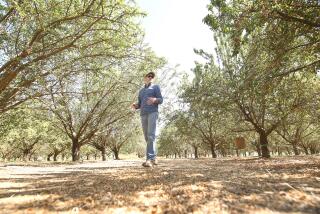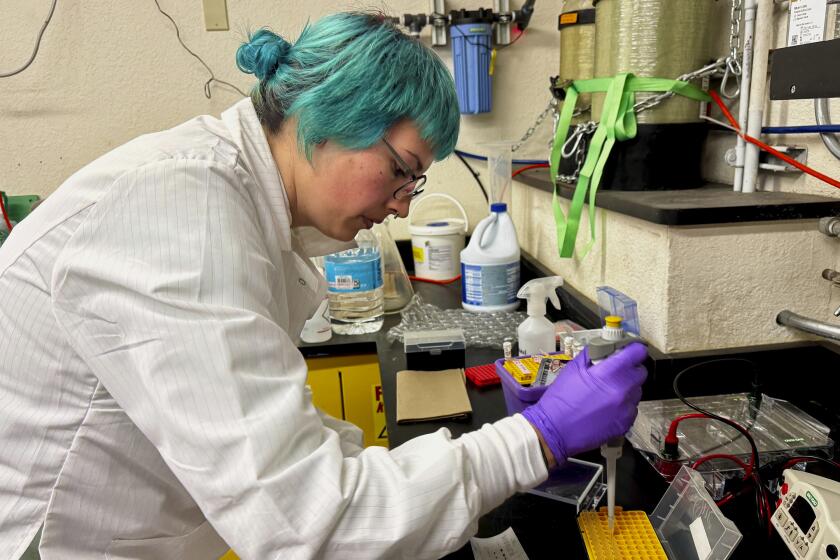Q&A: Why scientists in Los Angeles are so excited about a new collection of ancient amber
- Share via
Insects have been the most dominant land animals on the planet, as measured by mass and ecological effects, since before the time of the dinosaurs. Yet their biological bulk is not necessarily reflected in the traditional fossil record.
“If you are a big goofy dinosaur, you are going to be preserved in any kind of sediment that surrounds you,” said Brian Brown, curator of entomology at the Natural History Museum of Los Angeles County.
But if you’re a tiny insect, he said, things are considerably more complicated.
For hundreds of millions of years, insects — and the occasional small bird — have become trapped in the soft, sticky resin produced by trees after they suffer an injury. Under certain conditions, this resin will become buried in sediments beneath lakes or oceans, and solidify into amber. And when it does, it will preserve any organism stuck inside in exceptional, three-dimensional detail.
The Natural History Museum of Los Angeles County recently acquired 1,000 pieces of amber from David Penney, an entomologist (and powerlifter!) based in Manchester, England. Many pieces in the collection date back tens of millions of years, although a few are much more recent.
Each piece of amber holds some kind of treasure, but some are more scientifically extraordinary than others. Some of them contain extremely rare organisms that are known from only one other specimen. Others hold creatures that have never been seen before. And in some pieces, ancient bugs are caught in the act of mating, laying eggs or being a parasite on an unwitting host.
Brown and his team at the museum are now in the process of sorting through the collection to catalog exactly what they have and prepare some of the specimens for use by other researchers.
He spoke to The Times about why he convinced the Natural History Museum to purchase this particular collection, his favorite piece, and whether the public will get to see it firsthand.
Let’s start with the basics. What is amber?
Amber is fossilized tree resin. Resin is what trees produce when they are injured, like when a branch breaks off in a windstorm.
In order for resin to become amber it has to be extruded by the tree, fall into a stream, get washed out to sea, fall to the ocean floor and get buried in sediments.
Then it has to sit in that dark, oxygen-free environment for millions of years. This creates cross links between all the molecules in the resin and forms a stable structure that we call amber.
Wow. That’s a lot of steps.
The miracle continues. For us to find it, the ocean sediments have to be uplifted, the amber has to weather out, someone has to find it and someone interested enough has to mine it.
It is amazing that any one piece makes it through this whole process.
What makes amber so good at preserving insects?
It’s stable, so it preserves and protects the structure of the creatures that get caught inside it. It doesn’t preserve the actual cell content, like the DNA or anything, but it preserves the structure in great detail.
Is there any limit to how long it will preserve an ancient specimen?
Not as far as we know. The oldest amber we know of is a bit older than Burmese amber, which is 100 million years old. As long as the amber is protected from oxidation and light — the two things that make it brittle — it can last a long time.
Are there any other substances that can do this, or is amber the only game in town?
Hmmm. There’s nothing I know of that preserves animals within itself like amber does.
How big was the museum’s amber collection before this new addition?
It was about 3,000 specimens, but about half of them were of the family of fly I study, the phorid fly. We have one of the best collections in the world of phorid flies. But now we are starting to build our collection in other ways as well.
What makes this new collection special?
It’s a mixture of things. It is about half Baltic amber, which is 50 million years old, and the rest is Dominican amber, which is 20 million years old. It also includes a range of different insects from beetles to flies to wasps, and it has a big component of super-high-quality things — the Picassos and Renoirs of the amber world, if you will.
How large are these pieces?
They are various sizes, but most of them are about one-half to one inch long.
Amber, when it is mined, comes in chunks. Baltic amber, for example, comes in chunks the size of a walnut, although there can be nodules that are huge, like the size of a human head. Then the dealers cut them up and polish them for sale.
Do you have a favorite piece?
Oh yeah. There’s one specimen that shows the oldest known wingless female phorid fly copulating with the male of that species. It’s just a fabulous piece. I described this species in 1999 and later saw this pair pictured in a book. I thought, “One day it would be amazing to have that specimen.” Now we have it.
How much did this collection cost?
I’m not going to answer that question, but it wasn’t millions.
Will visitors to the museum get to see the new collection?
Amber is tough to display. If it is exposed to light for a long time it darkens up. And it will start to chip if it is exposed to oxygen.
I’m not in charge of what gets exhibited in the museum, but if we were able to build up a big enough collection, we could display parts of it to the public on special occasions.
This conversation has been edited for length and clarity.







